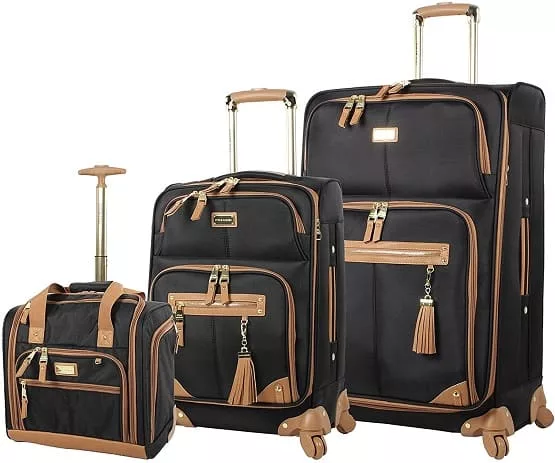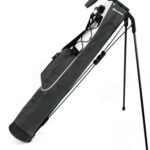
Have you ever been to the airport, debating between carrying your luggage or checking it in? Perplexed by all of the checked bag rules and fees, you may find yourself asking, “What is a checked bag anyway?” We’ve all heard the term regularly but never stopped to think about what it means.
Don’t worry – we’ve got you covered! In this post, unraveling the mystery surrounding checked bags will be our mission. We’ll explain what constitutes a “checked bag,” where baggage fees come into play, and how these practices have evolved.
You won’t need an airplane boarding pass to gain knowledge here: buckle up and prepare for take-off.
What Size is a Checked Bag?
When it comes to checked baggage, size matters. The specific dimensions for a checked bag depend on the airline, but in general, most airlines allow bags up to 62 linear inches (length + width + height) and 50 pounds. If your bag exceeds these parameters, you must pay an additional fee or check an oversized item.
Be sure to measure your bag before heading out to the airport. Most airlines charge extra if your luggage is too big or heavy when checking it at the ticket counter or gate.
It’s also important to check any restriction information on each leg of your flight, as some international flights may have different size parameters than domestic ones.
If you often travel with oversized items such as skis, snowboards, golf clubs, and other sporting equipment, most airlines will accept these as checked baggage with a special fee. Make sure to call the airline ahead of time to check the size specifications for such items.
Generally, it’s crucial to consider your baggage’s size when packing for a trip and ensure you know of any extra fees associated with checking larger or heavier bags. This way, you can avoid any surprises at the airport.
Maximum Weight for a Checked Bag
Most airlines impose a maximum weight limit for checked baggage. This limit can vary depending on the airline but typically ranges from 50-70 lbs (23-32 kg) per bag. Generally, most airlines will allow one piece of checked luggage that weighs up to 50 lbs (23 kg).
If your bag is within this weight limit, you may be subject to additional charges, or the bag may not be accepted. Before travel, you must check with your airline about their specific policies and restrictions relating to checked baggage weight limits.
In addition to maximum weight limits, most airlines have size restrictions for checked bags. The typical dimensions are 62 linear inches (157 cm), including handles or wheels. Oversized bags may be subject to additional fees or not accepted at all.
So, checking with your airline about their policies and restrictions relating to checked baggage size limits before traveling is important.
It’s also important to note that if you bring more than one piece of luggage, the weight limit applies per bag, not per person. For example, if two people are traveling together and have one piece of checked luggage, each weighing 70 lbs (32 kg) combined, then each bag must weigh no more than 50 lbs (23 kg).
Otherwise, the excess weight will need to be redistributed across other pieces of luggage, or additional fees may apply.
What is Allowed in a Checked Bag?
When packing for a trip, it’s important to understand what items can be packed in your checked bag. In general, any item the Transportation Security Administration (TSA) allows can be placed in a checked bag. However, there are some exceptions.
All travelers should be aware of which items are prohibited and not permitted into airline cabins or airport security checkpoints. These items include:
- Firearms and ammunition
- Explosives
- Flammable materials such as gasoline and propane tanks, aerosols, liquids over 3.4 ounces (100 ml)
- Self-defense sprays such as mace or pepper spray
- Knives or sharp objects with blades longer than 4 inches (10 cm).
If you plan to bring any items listed above, they must be placed in your checked bag. To ensure these items are safe, they should be packed in a hard-shell suitcase or secure container.
In addition to prohibited items, many airlines also have restrictions on what size and weight a checked bag can be. Check with your airline for their specific requirements, as they may differ slightly. Be aware that additional fees may be associated with larger or overweight bags.
How Much is a Checked Bag?

The cost of a checked bag can vary greatly depending on your airline, destination, and weight. Generally, domestic airlines in the United States charge between $25 and $40 per checked bag up to 50 pounds.
If you fly internationally, most airlines will charge more for checked bags due to additional fees. Additionally, you may be subject to additional charges if your bag is overweight or oversized.
To avoid any unwanted surprise fees, knowing the specific policies for each airline you fly with before checking a bag is best.
If you have an elite membership with certain airlines or belong to their frequent flyer program, checked baggage fees could be waived depending on the membership terms.
Additionally, some credit cards offer airline credits that you can use to pay for baggage fees. It’s always best to check the specific policies before purchasing a ticket to avoid any unwelcome surprises when boarding your plane.
Conclusion
I hope now you’ve understood what a checked bag is. When traveling by air, knowing the difference between a checked bag and a carry-on bag is vital.
That’s because most airlines have strict regulations regarding baggage allowance. You may be subject to additional charges if you exceed your airline’s limit. Be sure to check ahead with the airline to understand their baggage requirements better before you travel.
Using a checked bag allows for more flexibility when it comes to packing items. But remember that whatever items you bring will need to fit within your airline’s given weight and size limitations.
By understanding what a checked bag is, travelers can ensure they pack all necessary items while staying within their allowable weight limits to arrive at their destination stress-free.



